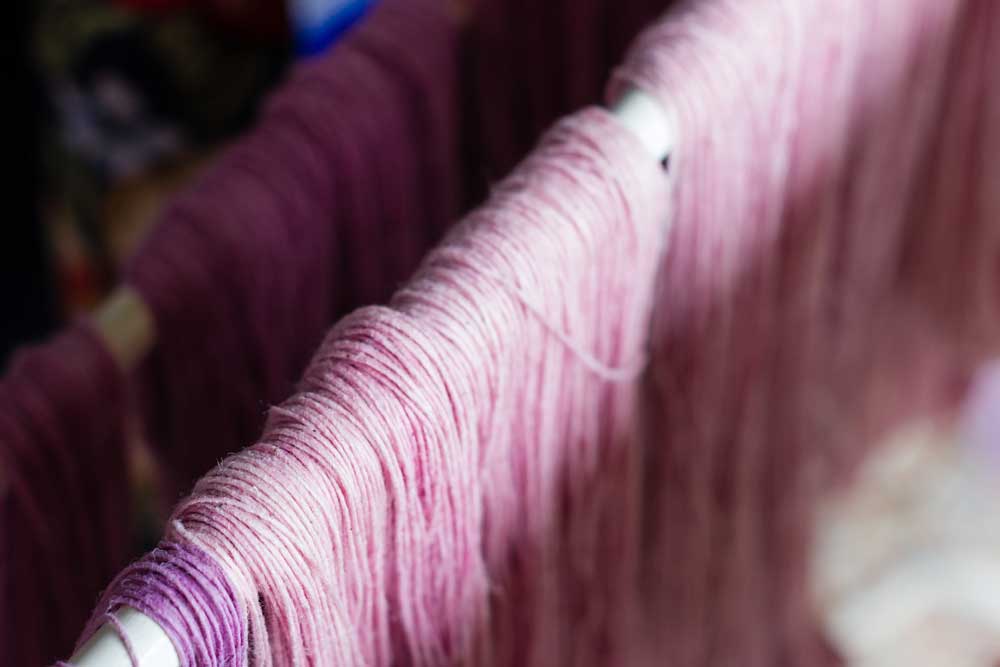As of April 2022, the Indian Trade Portal reported that the country had 385,596 power looms, contributing to 58.4 per cent of the total cloth production. Now it is a widely known fact that power looms definitely offer affordable alternatives to India’s economically diverse population. Their automated nature ensures both efficiency and rapid production output.
Handlooms, on the other hand, are time-honoured weaves that involve the labour of skilled artisans who use a manual loom to weave the fibres into something beautiful. Typically, these fibres are natural – cottons, linens or silks. Creating the weaves is both time and labour-intensive, which means each piece could cost more than its machine-made counterpart; so why should you choose a handloom?
‘Of course, there is a market for everything, and practicality plays a huge role while choosing between a power loom and a handloom,’ says Rohini Kamakshi, who runs a training centre for handloom weavers in Bengaluru. ‘However, to put it simply, there are three strong reasons to choose a handloom over a power loom,’ ‘The first, of course, is quality. Handlooms boast exquisite craftsmanship which absolutely shines through. A rich Chanderi silk or a Bandani dupatta definitely stand out, as opposed to say, a printed nylon sari. For occasions at least, it is ideal to invest in a few quality, handloom pieces that can be passed down as heirlooms.’
‘Secondly, handlooms create social sustainability, which is so underrated’ she adds. ‘The community of artisans engaged in traditional forms of handloom weaving is dwindling, because they aren’t adequately compensated for their labour and creativity. They simply cannot compete with the pricing of power loom products and it is snatching opportunities away from them. To sustain the weaving craft and craftsmen, it is important to purchase their products at a fair wage. Lastly, but most importantly, handlooms are much kinder, on the environment than power looms. Power looms guzzle so much energy, contributing to huge carbon emissions. There is also awareness now on the use of chemical-free dyes and organic materials that play a huge role in environmental sustainability,’ she says.
United Nations Climate Change states that the textile and fashion industry contributes 10 per cent of the overall greenhouse gas emissions because of the long supply chains and energy-escalated production. Additionally, almost 20–22 per cent of waste water is used. To power all the plants that produce fabric for the world, it takes a staggering amount of coal - 132 million metric tonnes to be precise! In comparison, handlooms don’t use any coal at all – or even electricity - which means they leave no carbon footprint and are ecologically sustainable. Advancements in biotechnology have also propelled the use of enzymes in the processing of textiles to decrease the ecological impact as well as wastage.

The handloom industry also produces significantly less waste, because products are made in small batches. If the fibres are fully natural – bamboo, lotus fibre, pineapple or flax - it helps as well. Cottons fall under the umbrella of handlooms, but organic or recycled cottons are preferable since regular cotton uses more water and pesticides. Although handlooms are keepsakes, those that eventually need to be discarded are fully bio-degradable and don’t occupy landfills for hundreds of years without breaking down. They can easily be composted without any negative environmental impact.
‘The process of manufacturing a handloom is quite simple and straightforward,’ says Utthara John, a second general Kerala-based textile entrepreneur. ‘Although some advancements in terms of technology have occurred, the basic process of handloom weaving has remained the same for centuries now, making it one of the most sustainable manufacturing processes. One selects the fibre, such as cotton or silk, and converts it to yarn through the weaving process. This weaving process varies depending on the nature of the fibre and intended weave. The yarns are then dyed. Although there was a time when chemical dyes made inroads into the handloom industry, there is increased awareness among weavers and consumers to embrace organic and chemical-free dyes again. This is still one of the problem areas though. Once we are able to minimise toxic chemicals, it will go a long way in making the industry sustainable. After the yarn is dyed, bobbin winding and warping take place to create the actual fabric. The warp yarns are sized, dressed and wound, then attached to a loom. Weft yarn winding also takes place, after which the fabric is woven and the final handloom product emerges. Final touches such as block print or embroidery are then implemented.’
The handloom industry embodies slow fashion in every sense – longevity and timeless garments made from natural, biodegradable fibres, and leaves a lesser carbon footprint compared to their mechanised counterparts. It is up to us now, whether we want to make a conscious choice to adopt this way of life. After all, as one of handlooms' earliest advocates Mahatma Gandhi said, ‘I see God in every thread that I draw on the spinning wheel’.